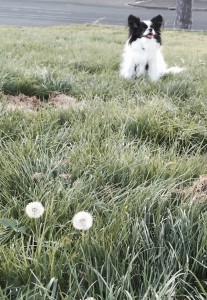The term ‘superfoods’ can be a favourite of many companies who see it as useful way of packing a premium price on their supplements or exotic food items for us or our pets. In my mind, a superfood is any nutrient dense food that supports great health – basically most types of organic, wholefoods fit that bill. And the best part is, most them don’t have to cost you a small fortune; in fact, many of the best superfoods are readily available and free – if you’re willing to overcome your aversion to what is commonly considered the bane of the garden…..yes I’m talking about weeds!
There are dozens of plants that we typically consider weeds that can be used to supplement our dog’s (and our own) meals. In this post I’d like to
talk about the many health benefits of good old Dandelion (or Taraxacum officinale for those preferring its botanical name!). I love this plant so much, I actually grow it in pots on my balcony (which draws quite a range of usually unfavourable reactions from those yet to discover its merits).
So what is so great about Dandelion and how can it support our pet’s health?
Benefits of Dandelion
Dandelion is a diuretic, supports detoxification of the blood and helps digestion. All parts of the dandelion can be used as a food supplement or to help treat different health conditions.
The beautiful golden flowers can be added to food serving as an antioxidant, supporting healthy immune function.
The lush, saw-tooth shaped leaves and roots can also be used, and are a great source of vitamins A, B complex, C and E. The plant also contains good levels of potassium, calcium and iron. According to herbalist Dr Randy Kidd in his book, Herbal Dog Care (2000), the leaves of Dandelion contain more beta-carotene than carrots!
In herbal medicine, it is often used to help cleanse the liver and gallbladder and stimulates the kidneys to remove waste in the urine. Herbalists use it in treatments for digestive upset, skin problems and arthritic conditions.
Where do I source it from?
Another benefit of this resilient plant (note ‘weeds’ are only in the eye of the beholder!) is that it is abundant in more temperate climates for most of the year – growing in the cracks of pavements, on nature strips, local parks and probably your own lawn. If you’re planning on picking your dandelion from the streets or public places, just make sure that it hasn’t been sprayed with any kind of pesticides, weed killers or other toxic substances by those who are less appreciative of its virtues (that’s why I like to grow my own). If in doubt or you are struggling to get fresh, you can use dried dandelion leaves and root.
How do I use it in my dog’s food?
If you’re using fresh, simply finely chop a flower or a couple of leaves and add it to your dog’s fresh meal. It is a great daily tonic or add it at least a few times a week to meals.
If you’re using dry, sprinkle about 1/4 teaspoon for every 2 kg of body weight.
You can also prepare a ‘tincture’ (effectively a tea for the non-herbalists out there) prepared from the fresh or dried parts of the plant and add it to your pet’s water if they are not averse to the taste.
A few things to note….
Dandelion is generally pretty safe to use with few side-effects but should not be used with animals that have bile duct issues. And less is more when it comes to any herb, so try not to exceed the recommended amounts.
There are a few other weeds that look similar to Dandelion (such as Cat’s Ears or Hypocharis radicata, which is also edible). One of the easiest identifiers is that the stem of the flower of the Dandelion is hollow and releases a white sap. But I recommend getting a little reference guide to help you identify them. I love The Weed Forager’s Handbook, by Grubb & Raser-Rowland (2012), but you can find others relevant to your local area.
Consider adding a little weedy superfood to your dog’s (and maybe your own!) food today for that extra nutritional punch.



